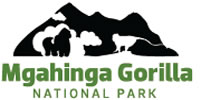In Mgahinga Gorilla National Park, there have been 39 mammal species recorded, although it is believed that up to 89 do occur in the park. The larger mammals include the mountain gorilla (Gorilla gorilla beringei), elephant (Loxondata africana) and buffalo (Syncerus caffer). There is also the rare golden monkey (Cercophithecus mitis kandti) known only to occur in the Virungas and two other forests in Central Africa, also recorded is the blue monkey. Other mammals include; the spotted hyena (Crucuta crocuta), the golden cat (Felis (Profelis) aurata), leopard (Panthera pardus), serval cat (Felis (Leptculurus) serval), side-striped jackal (Canisadustus), giant forest hog (Hylocheorus meinertzhageni), black-fronted duiker (Caphalophus nigrifrons), and bushbuck (Tragelaphus scriptus).
The park provides haven to about 79 bird species, including several endemic to the East Congo Montane region. A total of 185 bird species have been recorded in Volcanoes National Park in Rwanda, and most are likely to occur in Mgahinga Gorilla National Park.
Mgahinga Gorilla National Park is an afromontane forest, covering the smallest area as a vegetation type on the continent. The vegetation in Mgahinga Gorilla National Park consists of woodland, and only a small area of pure montane forest still remains at the base of Mt Muhabura following encroachment in the 1950s. Above the montane forest belt is the bamboo zone that stretches from the western boundary on Sabyinyo to the lower slopes of Muhabura. The Hagenia-Hypericum zone appears above the bamboo zone on Mt. Sabyinyo and below it on Gahinga. The Afro-Alpine Belt, characterised by giant Senecio and Lobelia species, occurs above the Ericacious Belt and reaches its maximum development on Mt. Muhabura.
